This paper is based mostly on the author’s experience with five Canadian university research consortia and the experiences of other Canadian university colleagues. It is the story of a strong, dynamic funding vehicle for supporting research and researchers that has succeeded for more than four decades in North America. Research consortia bring benefits to industry and universities, while leveraging government funding. Within some of the largest geoscience departments in Canada, research consortia funding supports 30-50% of the geophysical graduate student population.
A Brief History of Geophysical Consortia and Technical Impact on the Oil Industry
In exploration geophysics, the first major success in research consortia was initiated by Dr. Jon Claerbout who started the Stanford Exploration Project (SEP) in the early 1970’s. SEP was a success both financially and technically. Claerbout’s group initiated much of wave equation migration technology, and SEP has influenced much of seismic imaging in the industry. During his Ph.D. studies at MIT, Claerbout had observed researchers in the Geophysical Analysis Group (GAG) who initiated seismic digital processing – including the earlier developments of deconvolution by Enders Robinson and Sven Treitel. Claerbout recognized that cooperative efforts between the seismic industry and the university through research consortia could be very productive. Jon developed this model with the Stanford Exploration Project where he supervised over 50 Ph.D. students, who were completely supported by the industry funding. One of his Ph.D. students, Biondo Biondi directs the highly successful SEP today.
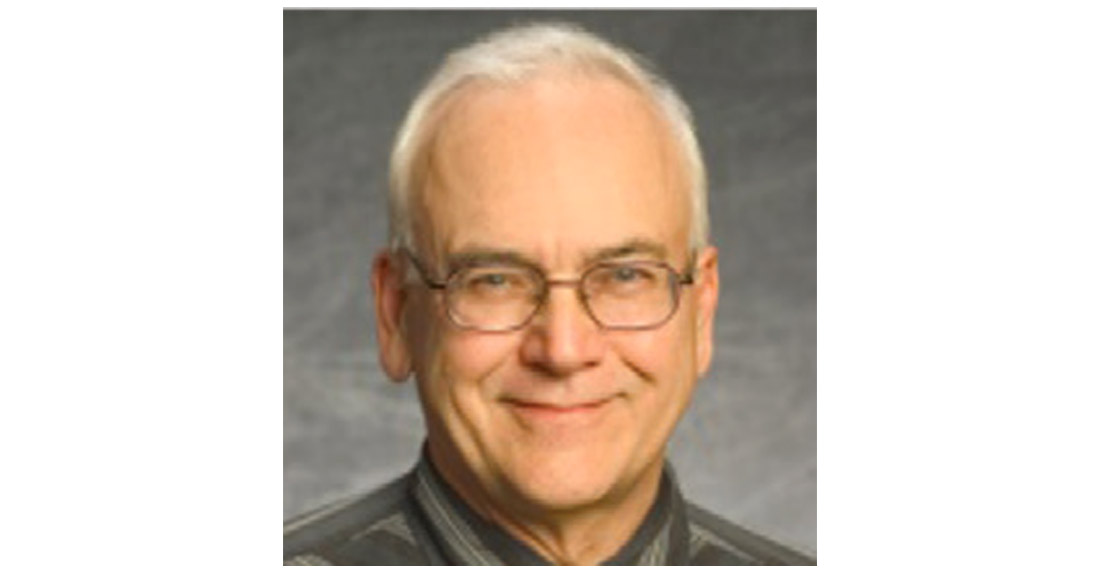
Photo from Stanford School of Earth Sciences web site.
The success of SEP was noted by another Ph.D. graduate from MIT, Dr. Robert Stewart. In 1987, Stewart , with colleagues Jim Brown and Don Lawton, initiated CREWES (Consortium for Research in Elastic Wave Exploration Seismology) – the largest exploration geophysics university consortium in Canada. The CREWES focus on elastic wave seismology led to the development of multicomponent seismology for a a more complete description of the seismic wave field. CREWES has won international awards (SEG Distinguished Achievement Award), national awards (NSERC Synergy Award), and provincial awards (the APEGA Summit Award).
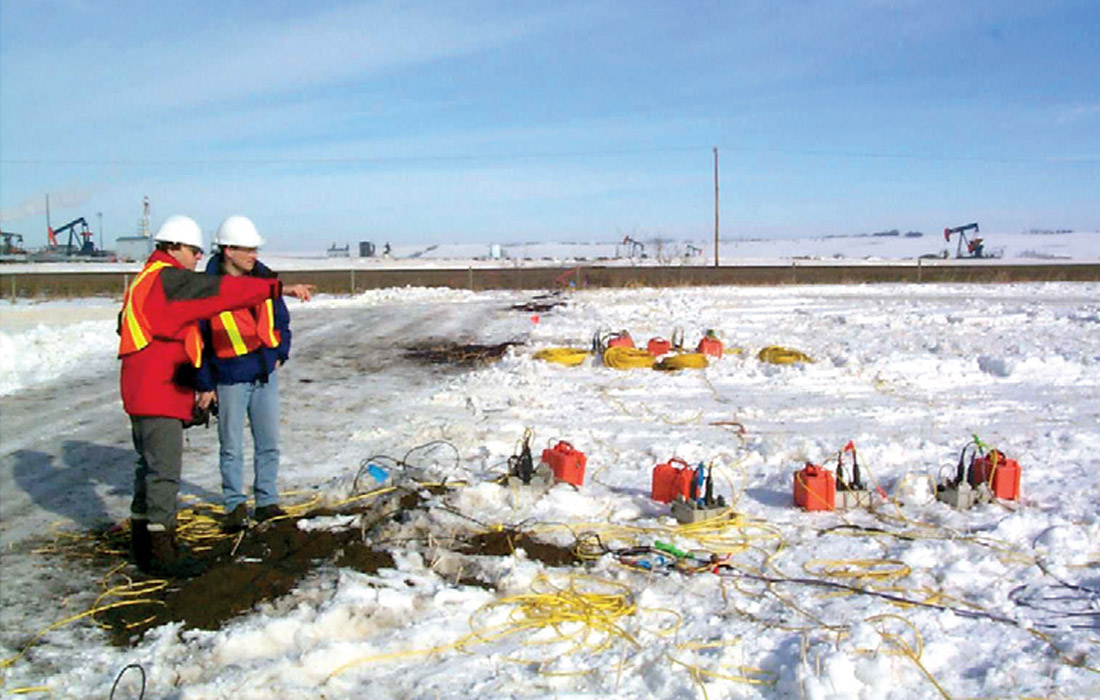
CREWES emphasized the importance of all aspects of multicomponent seismology including acquisition, processing and interpretation. CREWES recently celebrated its 25th Anniversary with an impressive record of accomplishments. As of May 2014, CREWES had a total of 147 graduate students (110 M.Sc. and 37 Ph.D. students) complete their degrees. There have been 1476 papers in their annual research reports and from 2001-2013, CREWES researchers have presented 556 conference abstracts at national and international conferences. The annual research budget is typically about $1.5 million per year. CREWES reports are available on a CD sold by the Society of Exploration Geophysicists. Figure 2 shows CREWES participation in a seismic survey near Lloydminster. Figure 3 shows the CREWES Directors of 2009 (Stewart, Lawton, Lines and Margrave), who were involved with CREWES and other research consortia.

FRP, (Fold-Fault Research Project) was a consortium that combined knowledge of structural geologists and exploration seismologists to image the petroleum traps in the Canadian Foothills. FRP was founded by Don Lawton and Deborah Spratt, of the University of Calgary, along with John Dixon of Queens University, in 1994. In terms of impact on the practices of the petroleum exploration industry, FRP researchers led by Don Lawton and Rob Vestrum demonstrated that anisotropic seismic imaging was needed to image structural traps beneath dipping shales. In shales, seismic velocities are anisotropic – with velocities being faster in directions parallel to bedding as compared to velocities for travel perpendicular to bedding. Failure to account for anisotropy caused a lateral mislocation of seismic depth images and missed drilling targets. The solution to the problem required anisotropic depth migration. Examples such as the one in Figure 4 were shown by Vestrum et al. (1999), and Yan et al. (2004). Today, anisotropic depth imaging of thrust belt structures has become a common practice in industry.
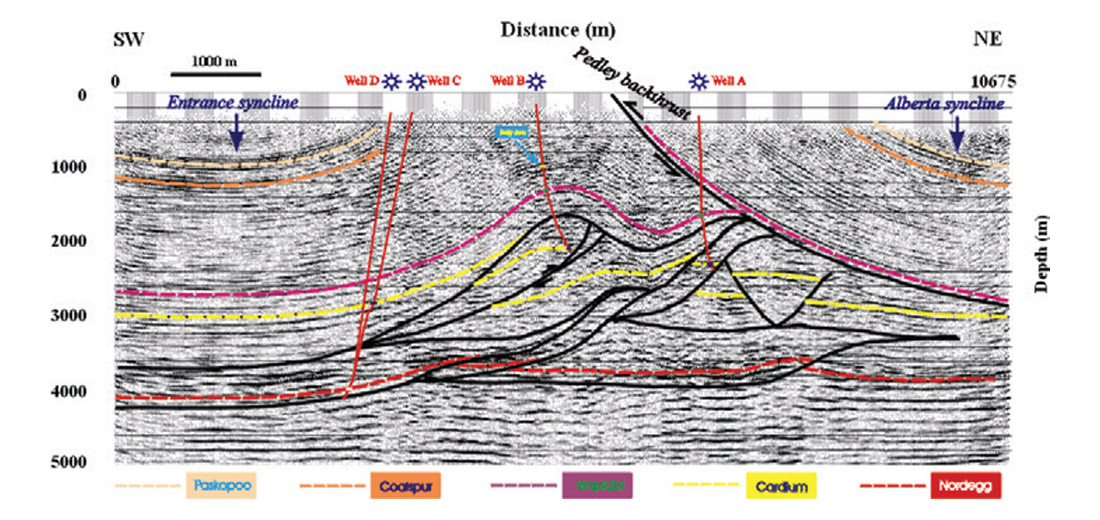
In addition to influencing exploration geophysics practices, research consortia have been involved in oil field development. An example of this was the role of the Memorial University Seismic Imaging Consortium (MUSIC), which participated in the East Coast oil field developments during the 1990’s. The NSERC/Petro-Canada Chair in Applied Seismology at Memorial University was established in 1993, during the development of Newfoundland’s Hibernia Field. The author, as NSERC Chairholder at that time, was encouraged by Petro-Canada to develop a research consortium. Thus, MUSIC was initiated by MUN professors, a cohort of graduate students, seismic processing technologists, and corporate sponsors who produced a series of reports, published papers, and theses describing East Coast exploration research.
Through these efforts, it became apparent that 3-D reverse-time depth migration was a very effective tool for defining the basin structures and the extensional faulting associated with petroleum traps in Hibernia field. Figure 5, from Kelly (1998) was one of the best examples of depth migration. The lower right reflection event from (x,z) coordinates of (4000m, 4500m) dipping upward to (7800m, 3000m) defines the basin-bounding fault of the Hibernia field. Sitting above the fault is a rollover feature (as indicated by the red arrow).
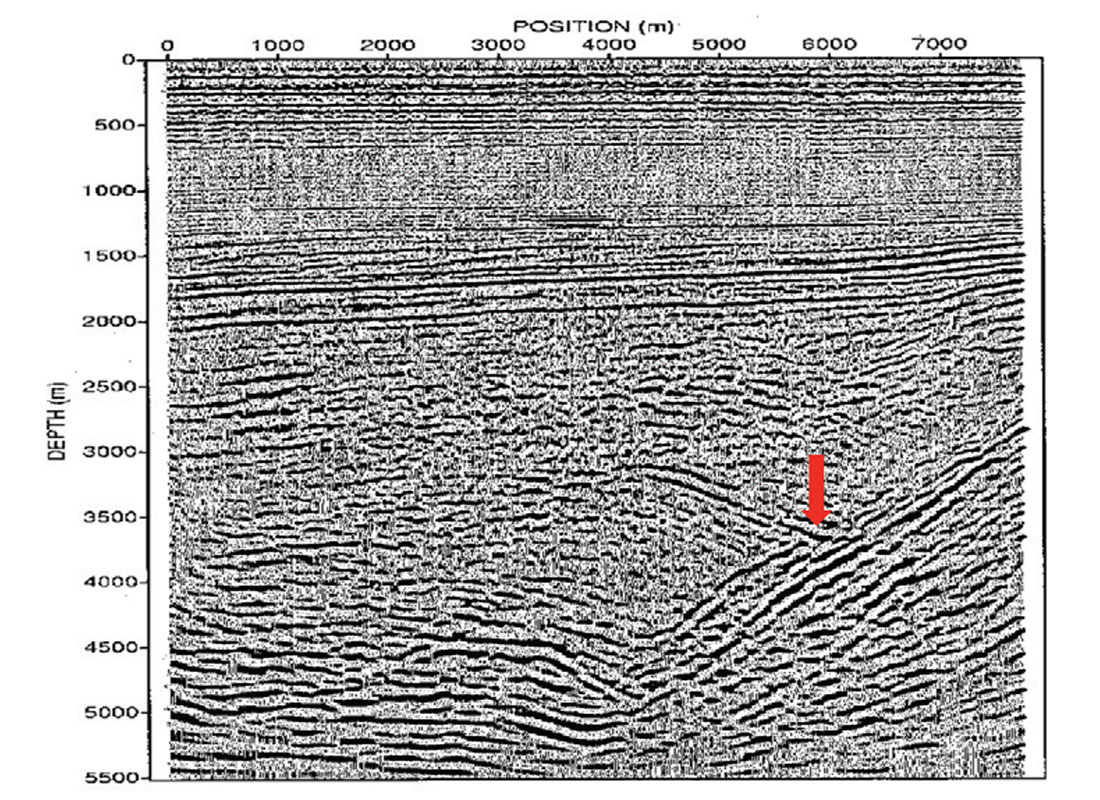
Canadian petroleum production is increasingly dominated by the exploitation of heavy oil fields in Western Canada. Enhanced oil recovery in these fields relies greatly on petroleum engineering methods to optimize production. CHORUS (Consortium for Heavy Oil Research by University Scientists) focuses on the reservoir characterization of heavy oil fields. CHORUS coordinated the research of geoscientists and engineers at the University of Calgary with Doug Schmitt’s rock physics lab at the University of Alberta. Much of the collaboration was made possible through the efforts of project manager, Joan Embleton. In consortia, a project manager coordinates the research contracts, the software installations, data handling, project and sponsor meetings, and communications with sponsors.
CHORUS has helped to pioneer three advancements in heavy-oil technology: seismic monitoring of cold heavy oil production with sand (CHOPS), interwell viscosity estimation, and the use of synthetic core. The seismic monitoring of CHOPS was implemented by Larry Mayo (then of Pan Canadian) in 1996 and later CHORUS and Husky researchers. Figure 6 illustrates how seismic monitoring can indicate the changes in a heavy oil reservoir due to CHOPS. In cold production, sand, oil, gas, and water are withdrawn from the reservoir. A consequence of CHOPS is that the P-wave seismic velocity is decreased and this change is manifested in two ways, as shown in Figure 6. In this figure, the top seismic section is taken from a 3-D seismic survey in 1989, while the bottom section was recorded in 1996. The traveltime differences between the above-reservoir and below-reservoir reflectors are increased by about 5-10ms. This is seen by comparing the M (Mannville) and R (Rex Sandstone) reflections in Figure 6. The right-most arrows in the two sections show the delay in the R reflector. The amplitude changes of seismic reflections within the Mannville reservoir unit are indicated by the left-most arrows in the figure.
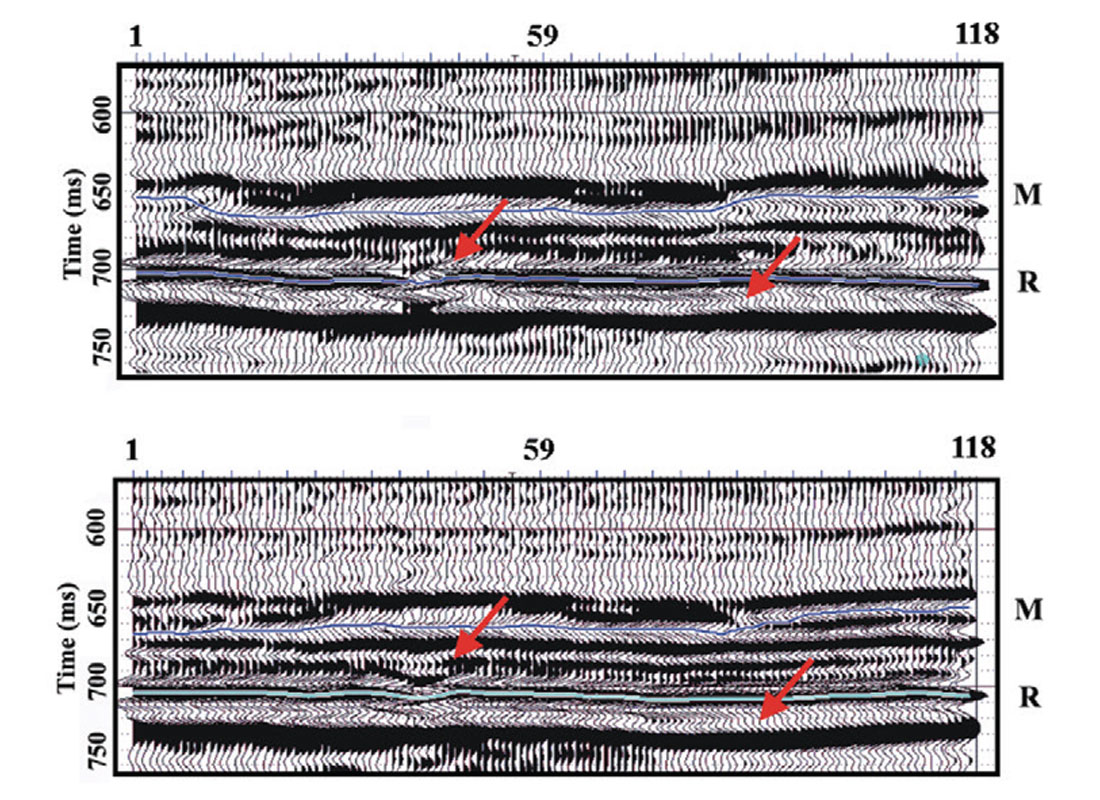
Heavy oil production has created environmental concerns involving water, land, and carbon emissions. A possible method for decreasing the environmental impact is the use of in-situ upgrading of heavy oil within the reservoir itself. The Alberta Ingenuity Fund created a centre for research into in-situ methods entitled the Alberta Ingenuity Centre for In-Situ Energy (AICISE). This centre at the University of Calgary, with the support of corporate sponsors, utilized the research of chemical engineers and geoscientists to combine thermal methods and solvents in the upgrading of heavy oil. An important goal of seismic monitoring is the detection of viscosity changes during hot production. The estimation of viscosity through cross-borehole seismic tomography was demonstrated in the Ph.D. thesis of Fereidoon Vasheghani who was funded by AICISE and CHORUS. Illustrations of a viscosity tomogram is shown below in Figure 7.
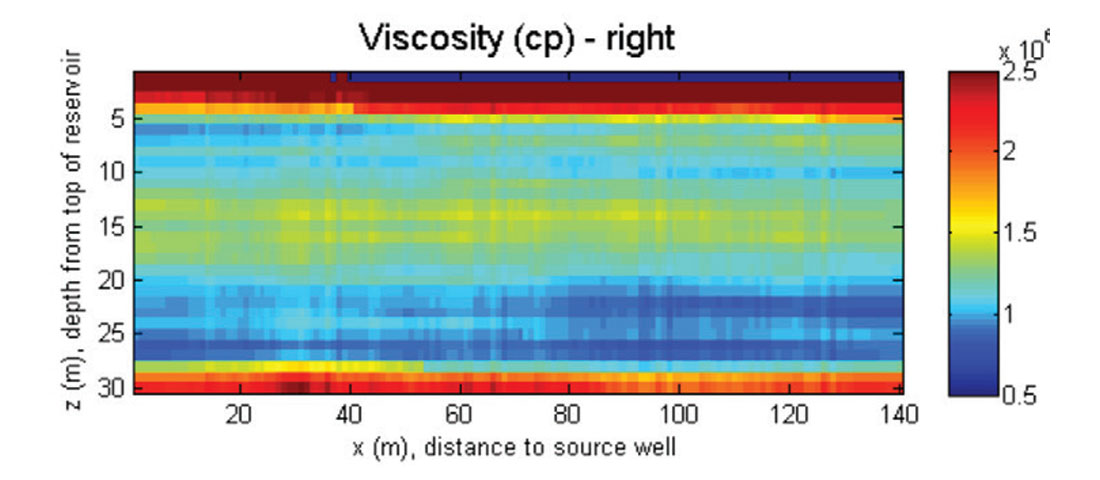
One of the main tools in the reservoir characterization of heavy-oil fields is the analysis of core for depositional environments. Some heavy-oil fields have well log information, lack core samples, but are near neighbouring oil fields that have logs and cores. A technique described by Alam (2012) utilizes the well log data (specifically gamma ray and neutron/ density logs) and geological templates of depositional environments to produce “synthetic core”. The “synthetic core” method was applied by CHORUS researchers to heavy-oil fields in Alberta and Saskatchewan. Self-validation has shown that the synthetic core simulates actual core very well. An example of synthetic core is shown in Figure 8.

The Seismic Signal Analysis and Imaging Group (SAIG) is a consortium at the University of Alberta that was formed in 2001 by Mauricio Sacchi. Today SAIG has grown to a total of 12 sponsors with 12 researchers (10 graduate students and 2 PDFs). SAIG’s contribution to the field of industrial exploration seismology can be summarized by work in the following two areas: (1) mathematical methods for seismic data preconditioning prior to imaging and (2) problems of seismic waveform inversion. Specifically, SAIG developed algorithms for data reconstruction and regularization of multidimensional (5D) seismic data. These algorithms have been adopted and improved by industry sponsors to become an essential component of modern seismic processing sequences. SAIG’s association with industry has made possible the training of graduate students in the area of seismic signal processing.
SAIG students have received best papers awards at National and International companies, and three Graduate students received the Clarence Karcher Award. (Figure 9 shows members of SAIG in one of the Award celebration.) As with all consortia, the continuous recruiting and training of talented Canadian and international students to study in Canada has a direct impact on maintaining the highest standard of industrial research in Canada.
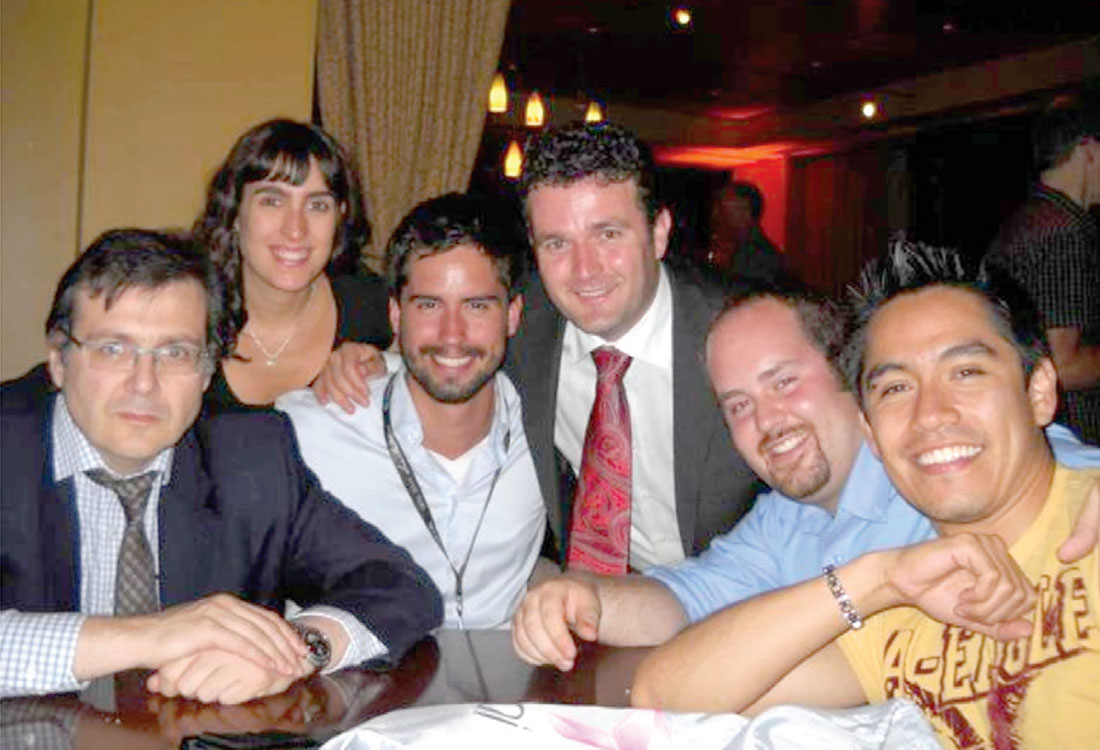
In recent years, there has been increasing interest in oil production from tight shale formation as initiated by fracking. In this process, it is important to detect the location of induced fractures. For these purposes, the methods of earthquake detection have been utilized in the oil patch. The Microseismic Industry Consortium (MIC) founded in 2010 (www.microseismic-research.ca) is a world-class geophysical initiative dedicated to advancement of research, education and technological innovations in microseismic methods and their practical applications for resource development. MIC is led by Dave Eaton at the University of Calgary and Mirko van der Baan at the University of Alberta, and is a team of faculty, students and postdoctoral researchers collaborating closely with government agencies and about 30 industrial sponsors. MIC’s research vision encompasses data acquisition, processing and interpretation within a multidisciplinary research environment. Key elements of this vision include creating improved algorithms for high-resolution microseismic event location and moment tensor inversion, and developing integrated case histories using microseismic and 3-D seismic data. MIC seeks to improve geomechanical simulation of fracture processes, understand the evolution of stress fields, while investigating temporal changes in reservoir conditions (including seismic anisotropy).
A unique characteristic of MIC is its commitment to design and acquisition of microseismic field experiments. To date, two major field projects have been undertaken in northeast B.C. and in central Alberta, with a third project being set to roll out in summer 2014. One project was designed to detect low-frequency tremor signals associated with “aseismic deformation”. A second project, as shown in Figure 10, used a downhole microseismic toolstring owned by the University of Calgary.
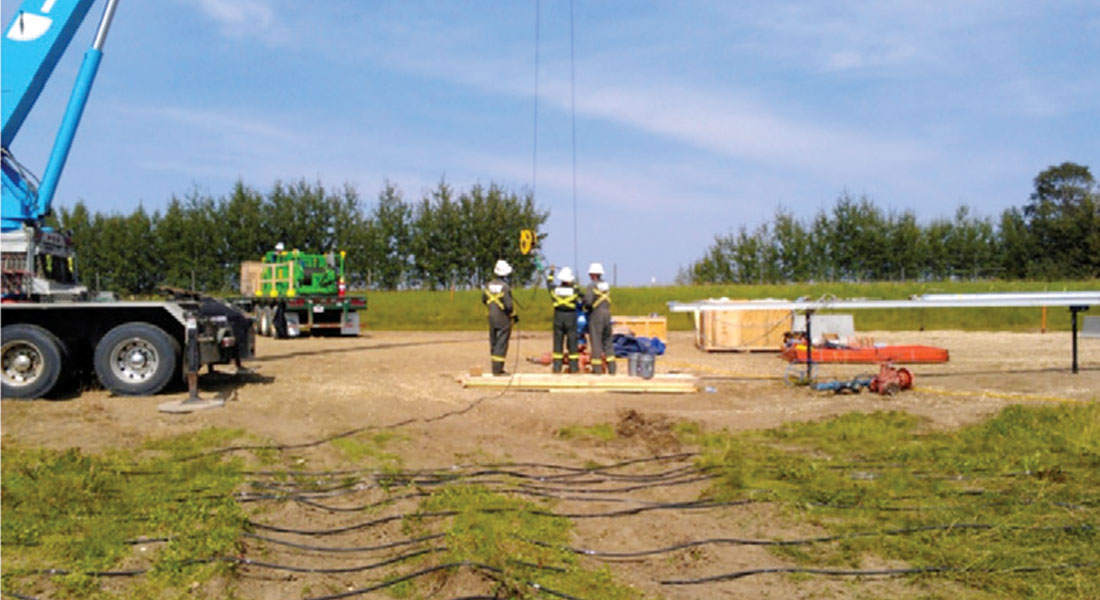
Benefits to Industry: HQP, data acquisition, data processing and software
During the next decade, the petroleum industry will undergo a “large crew change” as is evident from the present demographics of the industrial work force. The median age in the industry is about 47 and large-scale retirements are on the horizon. There will be a demand for new skilled labour. Companies will need to carefully consider the hiring of new graduates and it is crucial that these graduates have knowledge and skills in geology, geophysics and reservoir engineering. Through sponsorship of university consortia, companies will become acquainted with students that have these skills. The education of highly qualified personnel (HQP) is a huge responsibility for university consortia.
Moreover, graduate students involved in consortia will become acquainted with the latest research in petroleum disciplines. Sponsors will view the “first showing” of graduate student research. These new research ideas can be implemented by companies. In fact, consortium students have eventually created their own companies to serve the industry. Specialized data acquisition data processing for research purposes by consortia will also be of interest to the industry. With the downsizing of industrial research centres during the past decades, the university consortia play an ever increasing role in testing of new acquisition and processing ideas. Data sets acquired by consortia can be made available to sponsors and eventually to the industry at large. Many of the research ideas within consortia are tested with the development of new software. While graduate student software may not be suitable for widespread universal use in the initial stages, sponsors have in many cases taken software at the “alpha stage” and enhanced the codes to be suitable for commercial applications. Industry courses offered by consortia also prove to be useful for sponsoring companies. In fact, the flow of continuing education courses will go in both directions. Sponsoring companies provide training courses to consortium students to enhance their skills as employees within the industry.
Benefits to Universities
In recent years, university budgets and research grants have been cut by governments. While this is not a desirable situation, those in applied science and engineering have had to depend increasingly on industrial financial support for research. The consortium model allows this to be done by teams of companies who can receive the benefits of research with modest amounts of support. The financial support of graduate students has in many cases compensated for the reduced government spending.
In addition to financial support, few universities own producing oil fields, and much petroleum research is eventually carried out in such oil fields. The access to the oil fields owned by sponsoring companies is essential for applied research. The use of expensive equipment such as seismic recording systems has been made available by sponsors. The data gathered by these acquisition systems is essential to the thesis research of many graduate students.
Much of the specialized software used by geoscientists and engineers is very expensive to individuals involved in university research. The donation of consortium software has made possible much of the high-level petroleum research in universities.
Ultimately, university students in petroleum-related research will seek employment in industry. Most career opportunities are made possible through internships with companies. The consortia often pave the way for student internships. The students become acquainted with sponsoring companies and vice-versa. These internship relationships often lead to more permanent appointments within corporations.
Benefits to Government Funding: The Leveraging Model
While government spending on research may be constrained by economic challenges, government funding can be leveraged with consortium funding. One example of this is the NSERC CRD (Collaborative Research and Development) grant. The CRD program allows funding from consortia to be matched by NSERC. This both extends the influence of government funding and allows Canadian-based corporate sponsors to double their research investment. Since HQP is a large part of NSERC programs, the CRD would seem ideally suited for enhancing HQP.
Economic Importance of Research Consortia to the Canadian Oil Industry
While the world seeks alternative energy sources, the world’s thirst for hydrocarbons still continues to grow. This is due to a number of forces both in supply and demand. From the supply side, the discovery of giant conventional oil field discoveries is not increasing at the pace of demand. From the demand side, there are a number of emerging economies where consumer demand for petroleum-powered automobiles is increasing. In fact, demand continues to outpace supply and the price of a barrel of oil continues to reside at about $100 per barrel. In addition to energy needs, the world demand for plastics and petroleum- derived chemicals continues to be strong. Since petroleum exports account for an important part of the Canadian economy, with Canada exporting about 1 million barrels per day, it is crucial that Canadian universities continue to supply highly qualified personnel.
Preservation of Academic Freedom
Research within the Consortium model is done according to the university-industry-government contracts. As specified by contracts, work is done for collaborative research purposes, not for direct commercial applications. The consortium research has generally provided industry with ideas and results that have proved beneficial. There are many vehicles for technology transfer of research findings. Following initial presentations to sponsoring companies, research results generally appear in conference presentations, journal publications, and in graduate student theses. These research results are made available to the public through talks, papers and theses after a short period of time following presentation to sponsors. One could ask the question about why companies would choose to support research that is published. There are a number of reasons. Consortium sponsors will have a lead time over competitors in research. Sponsors are made aware of graduate students’ research whom they may choose to employ. The collaborative efforts of companies and consortia may help in the recruiting of talented future employees. There is the concern that academic freedom of university faculty may be compromised. In the experience of the author, there has not been a violation of academic freedom where university consortia are involved. We note that all technological advances described in this article have all been published. The libraries of the world are populated by journals, books and theses that contain the results of consortium research. The Canadian government has encouraged the collaboration of university consortia and industry, and in fact requires publication of results in peer-reviewed journals.
Conclusions: University Research Consortia in the Petroleum Industry – A Win-Win-Win Model
In summary, the university research consortium model represents a win-win-win model for universities, the petroleum industry, and agencies for government funding. Academics receive funding for their research. Graduate students receive financial support, data, and software for their thesis research. For their financial contributions, companies receive research results, software, data, and highly qualified personnel as future employees. Governments can have their financial contributions leveraged with industrial funding. There is the need to remain vigilant in the defense of academic freedom, but this has generally not been a problem. The future looks very promising for research consortia and in many ways represents optimum cooperation between industry and university researchers.
The Future of Geophysical Research Consortia at Canadian Universities
This article has focused largely on geophysical research consortia at Canadian universities over the past 25 years. It is not entirely inclusive, but is based largely on the author’s own experiences. Other research consortia will have their stories to tell. Geophysicists will ultimately ask this question. What lies ahead for consortia? I believe that there are many reasons for optimism. Canada is a resource-rich country and there continues to be a growing worldwide demand for Earth resources that are extracted in an environmentally friendly way. The petroleum industry is a high tech industry, and there is an increasing demand for hiring those with graduate school degrees in geosciences and petroleum reservoir engineering. Our universities are doing a better job of integrating science and engineering in reservoir characterization. Government funding for applied research is not increasing at the rate needed to supply highly qualified personnel. Industrial funding will be necessary and will be encouraged. All of these factors point toward a bright future for geophysical consortia.

Acknowledgements
This paper is based on a presentation given by Larry Lines at the APEGA Lethbridge Branch Annual General Meeting, March 27, 2014.
The article on geophysical consortia has resulted from the efforts of a large number of colleagues, graduate students, and project managers at several Canadian universities. The author would like to especially thank colleagues Rob Stewart, Don Lawton and Gary Margrave for contributed photos; and graduate students: Mahbub Alam, Irene Kelly, Fereidoon Vasheghani, Lanlan Yan, and Ying Zou for figures from their theses. David Eaton provided the information on MIC and Mauricio Sacchi provided the information on SAIG. Tom Sneddon invited me to present the APEGA talk upon which this paper was based, and Rob Holt of Shell Canada requested the paper for the CSEG RECORDER. Finally the input of Joan Embleton of CHORUS and Laura Baird of CREWES was greatly appreciated.




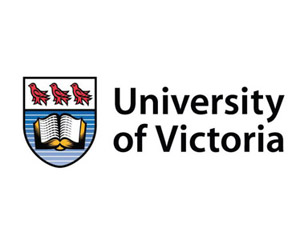
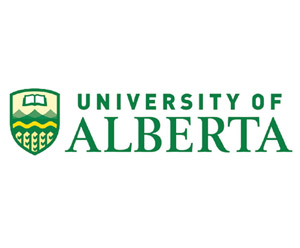
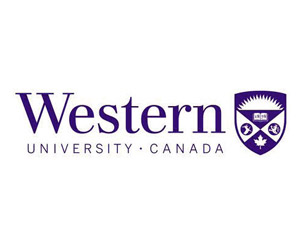
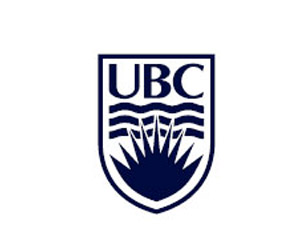






Join the Conversation
Interested in starting, or contributing to a conversation about an article or issue of the RECORDER? Join our CSEG LinkedIn Group.
Share This Article